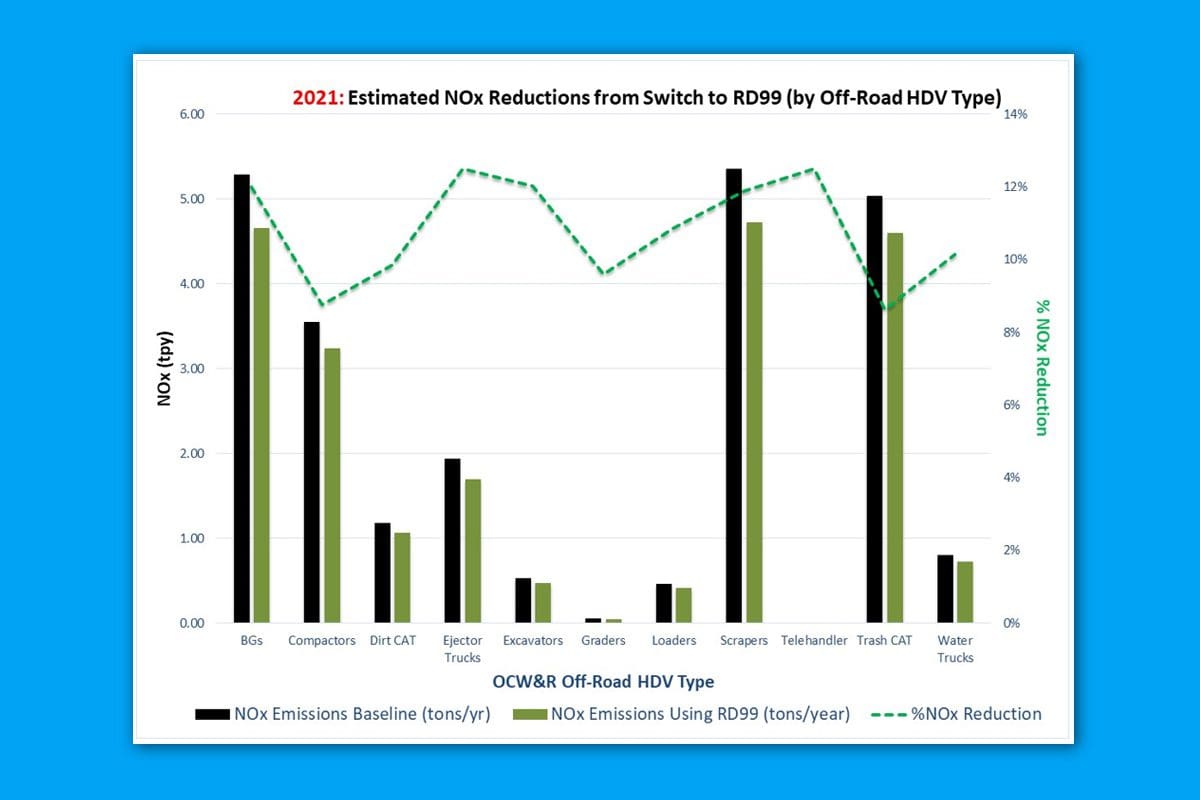GNA assessed the emission reductions that Orange County Waste & Recycling could achieve by fueling its fleet of landfill vehicles with renewable diesel.
- Emissions Assessments
- Education & Training
- Communications & Reporting

About the Project
Orange County Waste & Recycling (OCW&R) operates three active solid waste landfills in Orange County, California, supported by a fleet of 94 off-road heavy-duty vehicles (HDVs) powered by 104 diesel engines. GNA assessed the emission reductions that OCW&R could achieve by fueling 100% of its HDVs with renewable diesel.
Our Strategy
OCW&R had pilot tested renewable diesel (RD), but before fully embracing RD as a fleetwide sustainability strategy, wanted to better understand and quantify potential: 1) air quality and climate change benefits; 2) operational benefits; and 3) cost implications relative to the baseline case of continuing to fuel with ULSD. To assess, characterize and report all these types of potential benefits, GNA calculated baseline emissions for the fleet, including GHGs and criteria pollutants (NOx / PM / SOx), for comparison to emissions after fully switching the fleet to RD99.
For full-fuel-cycle GHG reductions, GNA estimated average carbon intensity of the RD99 blend OCW&R was likely to receive in large volume. For criteria pollutant reductions, GNA applied CARB off-road HDV emission factors for each HDV / equipment piece, as a function of certification Tier. GNA then applied average percentages of NOx / PM / SOx reductions achievable with RD99 as reported in best-available independent studies. GNA reviewed and assessed OCW&R’s estimated costs to fully switch to RD, described operational benefits of using RD99 (e.g., reduced costs and increased life for diesel particulate filters), and highlighted uncertainties that could potentially impact OCW&R’s ongoing ability to purchase sufficient volumes of affordable RD. The key report findings showed that fully switching OCW&R’s landfill fleet to RD99 would annually achieve:
- 8,937 metric tons of GHG emissions reductions (66% reduction from the ULSD baseline fleet)
- 2.58 tons of NOx reductions (11% percent reduction)
- 0.312 tons of PM10 reduction (29% reduction)
- 0.98 tons of SOx reduction (97% reduction)
GNA corroborated that OCW&R could achieve these emission reductions without making significant new capital or fuel-cost expenditures, due to RD99’s drop-in nature. Fuel costs for approximately 1 million gallons of RD99 would cost roughly the same as baseline ULSD, or possibly lower (energy equivalent). GNA also corroborated that OCW&R HDVs equipped with DPFs will likely require less maintenance after switching from ULSD to RD, and DPF life may be extended.

Figure 1: Bars (left axis) show estimated NOx emissions (tons per year) for all 94 OCW&R HDVs, before and after switching to RD99; right axis show % NOx reduction estimated for each type of off-road landfill HDV / equipment.
“OC Waste & Recycling is very pleased with the recent work of GNA. They were able to quantify that by switching to renewal diesel from conventional diesel, the department would achieve measurable improvements to our carbon footprint and reduce criteria pollutants with minimal capital investment. GNA’s used a science-based approach to help us make a business decision that further supports OC Waste & Recycling’s mission of environmental protection.”
David Tieu, Deputy Director, OCW&R
Start the Conversation
Let’s connect to discuss how GNA can help you achieve your goals.
